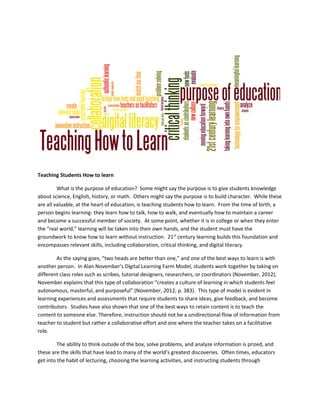
Philosophy
- 1. Teaching Students How to learn What is the purpose of education? Some might say the purpose is to give students knowledge about science, English, history, or math. Others might say the purpose is to build character. While these are all valuable, at the heart of education, is teaching students how to learn. From the time of birth, a person begins learning- they learn how to talk, how to walk, and eventually how to maintain a career and become a successful member of society. At some point, whether it is in college or when they enter the “real world,” learning will be taken into their own hands, and the student must have the groundwork to know how to learn without instruction. 21st century learning builds this foundation and encompasses relevant skills, including collaboration, critical thinking, and digital literacy. As the saying goes, “two heads are better than one,” and one of the best ways to learn is with another person. In Alan November’s Digital Learning Farm Model, students work together by taking on different class roles such as scribes, tutorial designers, researchers, or coordinators (November, 2012). November explains that this type of collaboration “creates a culture of learning in which students feel autonomous, masterful, and purposeful” (November, 2012, p. 383). This type of model is evident in learning experiences and assessments that require students to share ideas, give feedback, and become contributors. Studies have also shown that one of the best ways to retain content is to teach the content to someone else. Therefore, instruction should not be a unidirectional flow of information from teacher to student but rather a collaborative effort and one where the teacher takes on a facilitative role. The ability to think outside of the box, solve problems, and analyze information is prized, and these are the skills that have lead to many of the world’s greatest discoveries. Often times, educators get into the habit of lecturing, choosing the learning activities, and instructing students through
- 2. everything that happens in the classroom. However, to develop critical thinking skills, the educator must leave learning open-ended and let the students think for themselves. With as many digital resources as there are today, evaluating, analyzing and creating have never been so easy; however, a student can’t think critically with these tools if they don’t know how to use them productively. With the growing prevalence and accessibility of smart phones, computers, and other technologies, educators need to give students opportunities to practice using these resources for empowerment. Ferriter and Garry claim that “Today’s students can be inspired by technology to ponder, imagine, reflect, analyze, memorize, recite, and create-but only after we build a bridge between what they know about new tools and what we know about good teaching” (Ferriter and Garry, 2010, p.6). Heidi Jacobs in her book, Curriculum 21, claims “We should aggressively go out of our way to find better ways to help our learners demonstrate learning with the types of products and performances that match our time” (Jacobs, 2010, p.422). Tasks such as tutorial designing, making graphic organizers and game-based learning can promote digital literacy and critical thinking simultaneously. “Moving learning forward begins by introducing teachers to ways in which digital tools can be used to encourage higher-order thinking and innovative instruction across the curriculum” (Ferriter and Garry, 2010, p.6). To accomplish this, it is important to start small, making sure that each learning experience is authentic, meaningful, and relevant. While innovation takes change, and change is not always easy for students or educators, it is this change that will drive learning forward, build lifelong learners, and give students the best chance at success later in life. Citations Ferriter, W. M., & Garry, A. (2010).Teaching the igeneration: 5 easy ways to introduce essential skills with web 2.0 tools. Bloomington, IN: Solution Tree Press. Jacobs, H. H. (2010). Curriculum 21 essential education for a changing world. Alexandria, Va.: Association for Supervision and Curriculum Development. Kindle Edition. November, A. C. (2012). Who owns the learning?: preparing students for success in the digital age. Bloomington, IN: Solution Tree Press. Kindle Edition.